An overview of traceability in the automotive industry and the important part played by barcodes
by Carl Gerst, Cognex
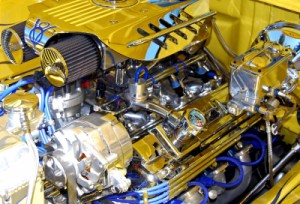 The worldwide automotive industry is in a perpetual state of change. Globally-linked economies, tight competition, and emerging markets all force constant review of production goals, suppliers, and long-term strategies. With the focus on improving quality, reducing costs, optimizing processes, and ultimately improving time-to-customer throughout your supply chain, having a strong traceability initiative is a key component to overall success. Traceability for the automotive industry is a process that documents the genealogy of the parts and subassemblies associated with a specific vehicle or range of vehicles. The type of information tracked will vary, but some of the more commonly collected information includes:
The worldwide automotive industry is in a perpetual state of change. Globally-linked economies, tight competition, and emerging markets all force constant review of production goals, suppliers, and long-term strategies. With the focus on improving quality, reducing costs, optimizing processes, and ultimately improving time-to-customer throughout your supply chain, having a strong traceability initiative is a key component to overall success. Traceability for the automotive industry is a process that documents the genealogy of the parts and subassemblies associated with a specific vehicle or range of vehicles. The type of information tracked will vary, but some of the more commonly collected information includes:
- source manufacturer
- manufacturing or assembly facility
- place of origin
- production time and date
- lot number
- part number
- model number
- serial number
- components used in assembly
- expiration date, etc.
All of this data can be accumulated and combined into a barcode and marked on the part. Barcode readers then decode the data throughout the part’s lifecycle and reliably transfer the information into an Enterprise Resource Planning (ERP) software system ensuring full traceability for each part of a finished vehicle. A question could be: is it worth putting a barcode on each of the 10-20,000 parts that make up an automobile? The answer is: yes, it is.
Program goals
Cradle-to-grave visibility of data is vital for those who make, store, or move items through the supply chain because the data is used in production output calculations, inventory control, revenue forecasting, warranty, repair, service and support solutions, and other business operations. It is also critical to increasing throughput and lowering production costs.
Monitoring process control
Real-time tracking systems can help reduce lead times and optimize the supply chain by providing information about work movements from zone to zone. These tracking systems are based on work in process (WIP) identification and associate the data with order management and other control systems. If or when you find a bottleneck or problem, you will know what it is as well as where it is within the process.
Implementing error proofing methods
Traceability poka-yoke (an error proofing mechanism used in a lean manufacturing process) improves quality by ensuring that the appropriate processes are performed in the correct sequence on the right parts. In addition to eliminating manual part number data entry errors, code reading can also assist in data logging for safety, liability, and warranty issues, and satisfy regulatory requirements for permanently identifying high-value parts that are subject to theft or counterfeiting.
Minimizing rejects and recalls
Larry Graham, global manager for manufacturing technology at General Motors, said that, dealing with a bad part, known in industry speak as a ‘spill’, at the supplier plant can cost between $25,000 and $500,000 USD. This is how much it could cost to find the problem, fix it, and then find and fix all of the affected parts. If this part makes it further downstream to the assembly plant, it could cost exponentially more (up to $1 million USD) to fix, as well as damage the supplier’s quality rating with the automaker. Should the problem reach consumers while the automobile is in service, the total recall costs can be 10 times that. With a solid traceability program in place, these costs remain at the minimums with the least disruption.
Complete part traceability
Marking parts and subassemblies at every step of the manufacturing process assures full traceability. With the availability of cost-effective image-based ID readers for every application and budget, you are no longer bound by selecting a limited number of code-reading checkpoints.
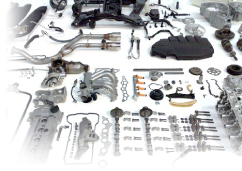
Component level
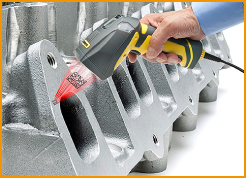 Serial numbers and other information like quantity, date, location of origin, and supplier can be converted to barcodes and either directly marked on components or printed on labels. Barcodes can also contain warehousing instructions. In high volume automated production, for example, a robot may unload parts or cartons from a pallet. As the robot unloads it moves items by a fixed-mount reader to scan the barcode and send the data to the management system. Matching engine and part barcodes with pallet codes ensures every part is in the right place at the right time. DPM (Direct Park Mark) traceability also provides greater operational visibility into your plant.
Serial numbers and other information like quantity, date, location of origin, and supplier can be converted to barcodes and either directly marked on components or printed on labels. Barcodes can also contain warehousing instructions. In high volume automated production, for example, a robot may unload parts or cartons from a pallet. As the robot unloads it moves items by a fixed-mount reader to scan the barcode and send the data to the management system. Matching engine and part barcodes with pallet codes ensures every part is in the right place at the right time. DPM (Direct Park Mark) traceability also provides greater operational visibility into your plant.
For WIP tracking, the process environment affects how DPM codes are applied and read. For example, it is important to make sure that your ID readers can decode the mark on the part as it moves from its raw, unfinished state through a chroming process that alters its finish.
Sub-assembly
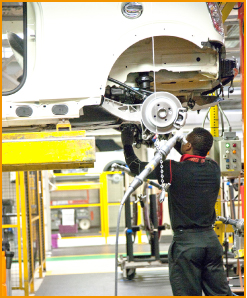 Production history can be gathered automatically by marking and reading codes and then integrating the data collected with your ERP system. To avoid production errors, most manufacturers have build sheets with barcodes for their operators to scan while building up the subassembly. This approach significantly helps operators avoid mistakes in operations involving many similar components. The result is improved productivity and quality with reduced scrap and rework. In addition, monitoring the assembly process ensures that each task has been completed and that all of the components have been added to the system. Diverters can be triggered to send the subassembly to each subsequent production stage. The history of each component of the subassemblies can be fully documented, enabling prompt response in the event of problems.
Production history can be gathered automatically by marking and reading codes and then integrating the data collected with your ERP system. To avoid production errors, most manufacturers have build sheets with barcodes for their operators to scan while building up the subassembly. This approach significantly helps operators avoid mistakes in operations involving many similar components. The result is improved productivity and quality with reduced scrap and rework. In addition, monitoring the assembly process ensures that each task has been completed and that all of the components have been added to the system. Diverters can be triggered to send the subassembly to each subsequent production stage. The history of each component of the subassemblies can be fully documented, enabling prompt response in the event of problems.
When kitting, check cards or other documents may be printed with long 1-D codes while parts are marked with small DPM codes. When the same station requires the operator to read a small code and then a long code, they would traditionally use two different readers, slowing throughput. Cognex provides single-reader solutions for this application in the DataMan 8000 series. These handheld readers feature integrated variable focus technology to increase efficiency and reduce cost and complexity.
Major assembly
The largest adopters of DPM identification, driven by: six-sigma quality initiatives, regulations (such as the TREAD Act in the U.S.), and high risk components, include foundries, manufacturers of powertrain components, and makers of safety-critical components such as axles, brakes, and steering gears. But still more can be done. Finished products with incorrect components that make it all the way to final quality control (QC) will have to be reworked, causing substantial losses to productivity. Tracking historical data including time, date, location, operators’ names, and all details of assembly achieves regulatory compliance and helps meet your customer’s demands easily. Information is king.
Final assembly
Operators using an instruction sheet to help select final assembly components can eliminate most errors by scanning each assembly individually to correctly identify the major assemblies and subassemblies to be mounted. This procedure also provides a tremendous amount of data for continuous process improvement and enhances asset tracking for final assembly stages. Mark and scan to track the final product to its next destination. Data could include quantity, customer name, and destination of shipment for each part number. Total traceability is essential for tracking repair, service, and support issues later on in the lifecycle and ensures that a part is authentic at its ultimate location. For part tracking, reliable ID reading is a requirement to keeping your line moving toward meeting daily throughput goals. Do not let ‘no-reads’ slow you down.
2-D codes
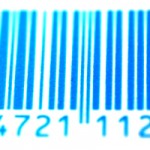 To address full lifecycle traceability, automakers and suppliers permanently mark parts with two-dimensional (2-D) codes. Direct Part Marking (DPM) has proven to be a cost effective way to uniquely mark and identify individual parts, subassemblies, and finished goods until the end of their useful life. 2-D codes are used for DPM applications due to their small size, error correction, and amount of data that can be stored as compared to 1-D linear barcodes. DPM codes also help with anti-counterfeiting measures as they are more difficult to replicate. 2-D codes are marked directly on the part using several methods depending upon the material composition, part application, and environmental conditions. Common methods that can withstand harsh automotive manufacturing environments include dot peening, laser marking, inkjet printing, and electro-chemical etching. Imaging technology is used to read 2-D codes because laser scanners can only read 1-D barcodes. There is a wide range of cost-effective, image-based ID readers available for all of your 1-D and 2-D barcode applications.
To address full lifecycle traceability, automakers and suppliers permanently mark parts with two-dimensional (2-D) codes. Direct Part Marking (DPM) has proven to be a cost effective way to uniquely mark and identify individual parts, subassemblies, and finished goods until the end of their useful life. 2-D codes are used for DPM applications due to their small size, error correction, and amount of data that can be stored as compared to 1-D linear barcodes. DPM codes also help with anti-counterfeiting measures as they are more difficult to replicate. 2-D codes are marked directly on the part using several methods depending upon the material composition, part application, and environmental conditions. Common methods that can withstand harsh automotive manufacturing environments include dot peening, laser marking, inkjet printing, and electro-chemical etching. Imaging technology is used to read 2-D codes because laser scanners can only read 1-D barcodes. There is a wide range of cost-effective, image-based ID readers available for all of your 1-D and 2-D barcode applications.
Connectivity
Traditional serial communications are used in cases where the read data stays “local” to the work cell, or in equipment where you want to connect directly to a PC, PLC (Programmable Logic Controller), or machine controller that may already be handling network communications. An Ethernet network provides computing systems access to plant floor data and allows intelligent devices such as vision systems and ID readers to share information for tasks such as managing inventory, tracking parts, and automating production line changeovers. Fixed-mount and handheld image-based barcode readers are both now available with true Ethernet connectivity that allow you to scan barcode data directly to the network of PCs, databases, and PLCs without the need of any special transfer devices on the floor. Be sure the ID readers that you select support industrial protocols such as:
- etherNet/IP with AOP
- Profinet with Siemens GSD
- MC protocol
- Modbus/TCP
- TCP/IP and FTP
Scalability is also enhanced with Ethernet integration. As ID readers proliferate across your operations, they can be centrally managed, providing a much lower cost-of-ownership
Automotive traceability example
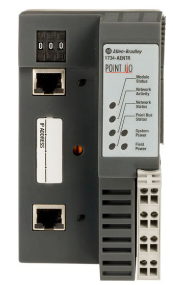 1. An intake manifold is labeled with a barcode containing assembly date and time, production line, and supplier.
1. An intake manifold is labeled with a barcode containing assembly date and time, production line, and supplier.- 2. A scanner reads the code to start the process of building the induction system.
- 3. The induction system’s record adds data at each step of production like the amount of torque applied to each bolt.
- 4. Scanners also read 1-D and 2-D codes marked on parts like the fuel rail, air box, sensors, and throttle subassemblies to add data to the master record.
- 5. That data is then automatically verified with the ERP system to ensure correct assembly sequencing.
- 6. Finally, a barcode is added to the part as it is packaged for shipment to the engine plant linking the entire subassembly to the file.
Now the subassembly has been completely tracked and problems can be corrected easily. One simple scan of a barcode can retrieve its complete history and associate all of the components used for easy troubleshooting.
